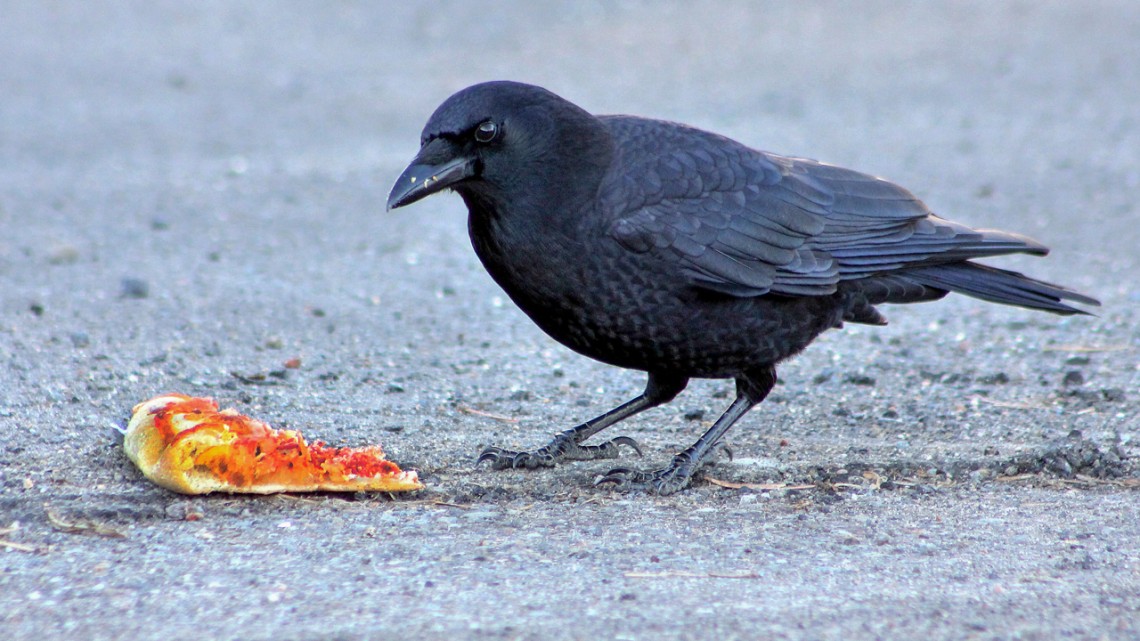
One characteristic of urban wildlife, including an American Crow seen here, is their taste for a wide variety of foods.
City-dwelling wildlife demonstrate ‘urban trait syndrome’
By Pat Leonard
City life favors species that are adaptable and, among other things, not too fussy about what they eat. A worldwide consortium of scientists calls the resulting collection of characteristics “urban trait syndrome.”
Their study includes data from 379 cities on six continents, with the largest data set coming from the Cornell Lab of Ornithology’s eBird program. The research was published Aug. 8 in Nature Communications.
“The most pronounced changes among city-dwelling organisms are in reproduction and foraging,” said co-author Frank La Sorte, a senior researcher associate at the Cornell Lab. “For example, city birds tend to be smaller, eat a wider variety of foods and produce smaller clutches than their rural counterparts. Smaller clutch sizes in urban birds have been associated with higher survival rates and increased growth.”
But not all groups of species share the same urban trait syndrome. Beetles, birds and reptiles tend to be smaller in the most urbanized areas compared to their country counterparts. The mobility of ground beetles was higher in more urbanized areas, while that of reptiles and birds was lower.
An organism’s level of mobility plays a role in how it looks for food. The study authors identify four types of foraging behaviors among the urban creatures studied: mobile generalist; mobile specialist; central place forager; and site specialist.
Both birds and bees are central place foragers, meaning they have a base of operations and make daily trips out and back to find food.
“The most common dietary strategy for birds in urban areas is to be a generalist – they’ll eat a variety of different foods instead of specializing,” La Sorte said. “You see this clearly among such common city birds as the rock pigeon, European starling and house sparrow. The specialists gradually disappear.”
As the dietary specialists disappear, biodiversity goes down in cities and the species mix becomes increasingly homogenized. Yet biodiversity is what keeps an ecosystem heathy.
Urban ecology is a growing field of study, driven in part by human population growth and the expansion of many of the world’s largest cities. One of the biggest hurdles when addressing questions in urban ecology is a lack of comprehensive information within cities. Much of the existing ecological data, apart from birds, is scarce and not gathered in a systematic way that allows for accurate comparisons across cities.
The growth of citizen-science programs such as eBird, in which volunteers compile observations of the natural world, have the potential to address this information gap.
“Preserving habitat is critical,” La Sorte said. “Ecosystems in cities are heavily transformed and managed, and intact native vegetation tends to be scarce. The more components of an ecosystem that are preserved and supported, the healthier the overall urban environment will be.
“That support could be in the form of expanded parks and green spaces, or by supplying artificial nesting resources as ways to partially compensate for habitat lost to city expansion,” he said. “It’s a more nuanced approach to urban conservation, aimed at keeping cities healthy for nature and people by accounting for the needs of many different types of species.”
This research was conducted as part of the Urban Biodiversity Research Coordination Network, funded by the National Science Foundation.
Pat Leonard is a writer for the Cornell Lab of Ornithology.
Media Contact
Adam Allington
Get Cornell news delivered right to your inbox.
Subscribe
